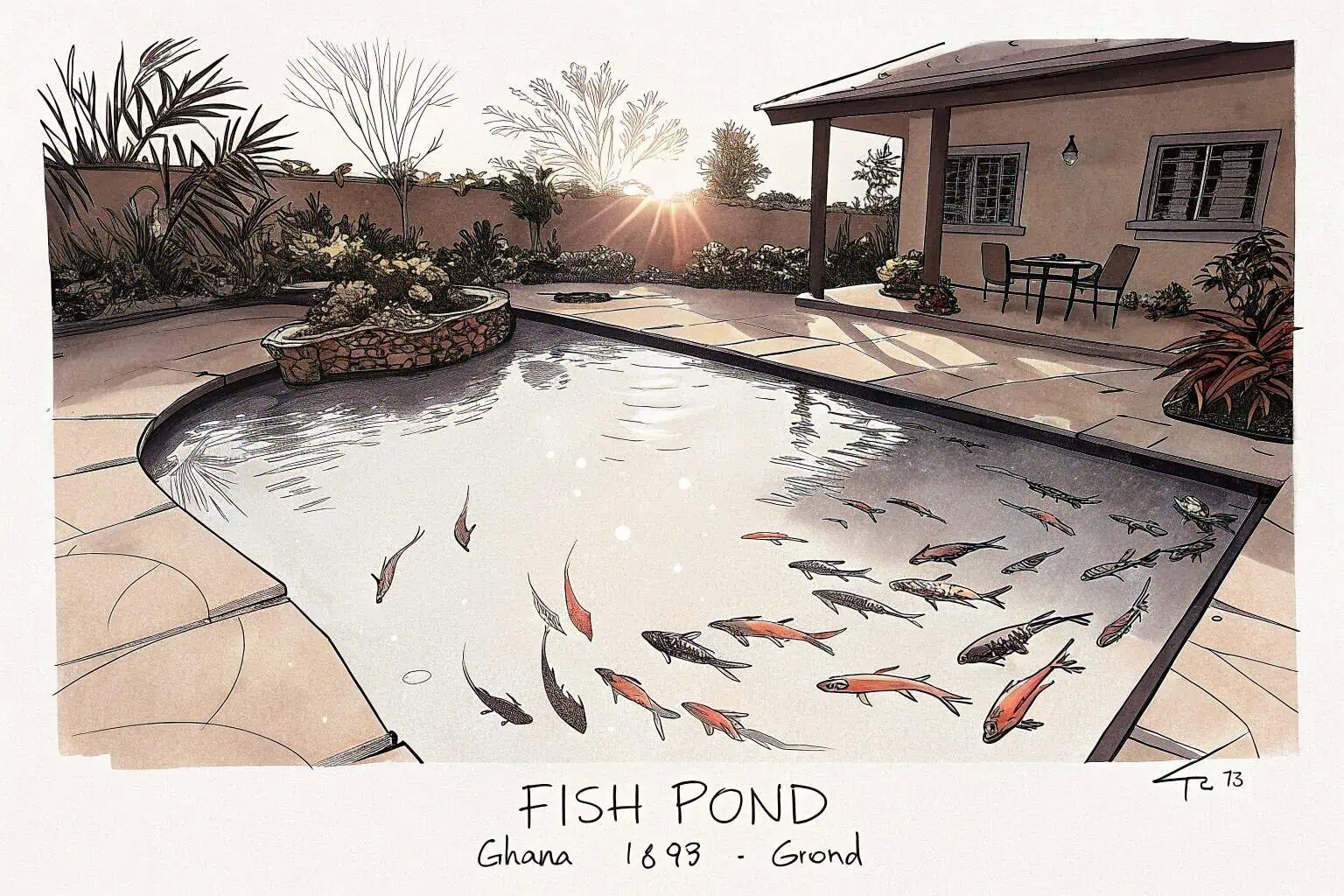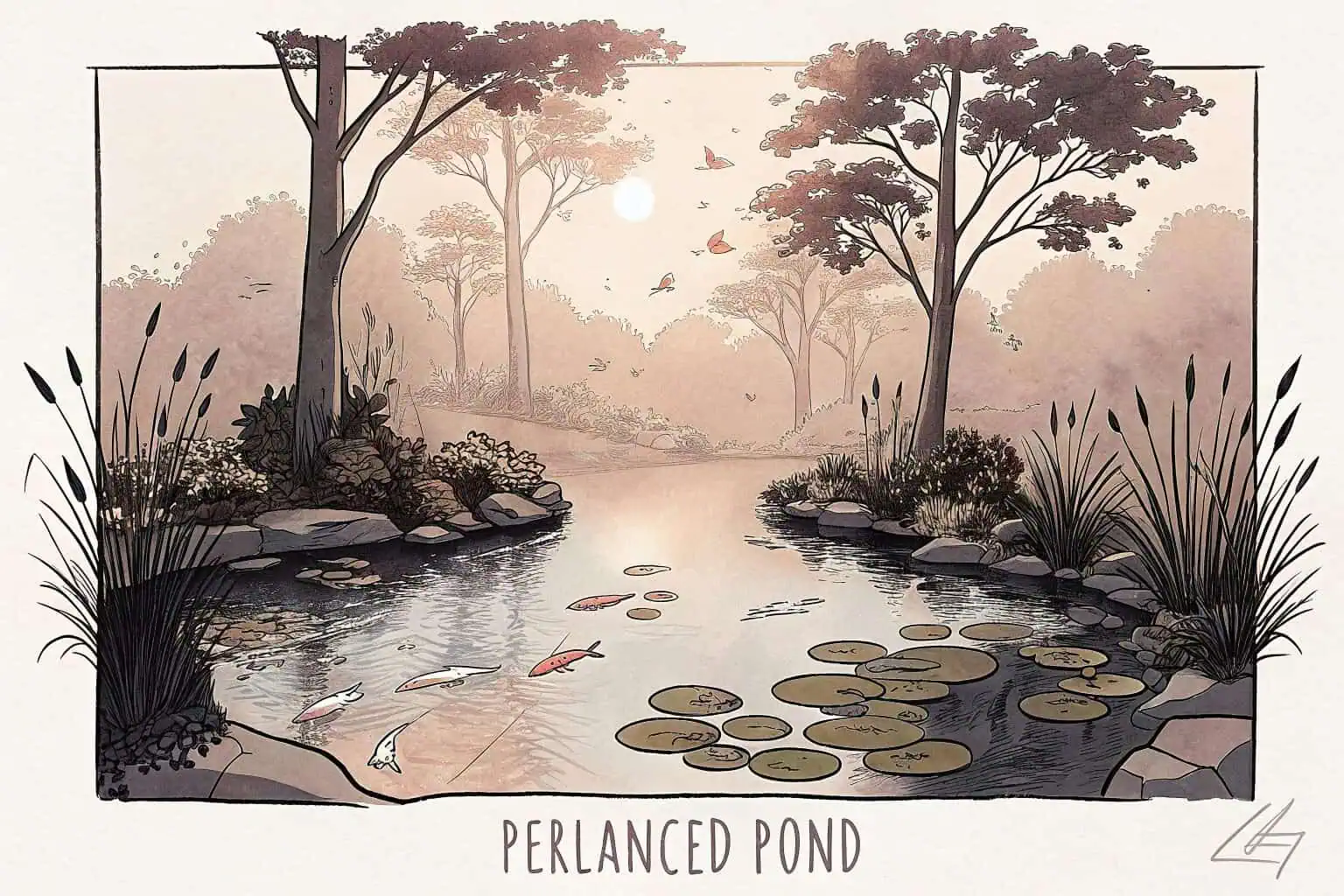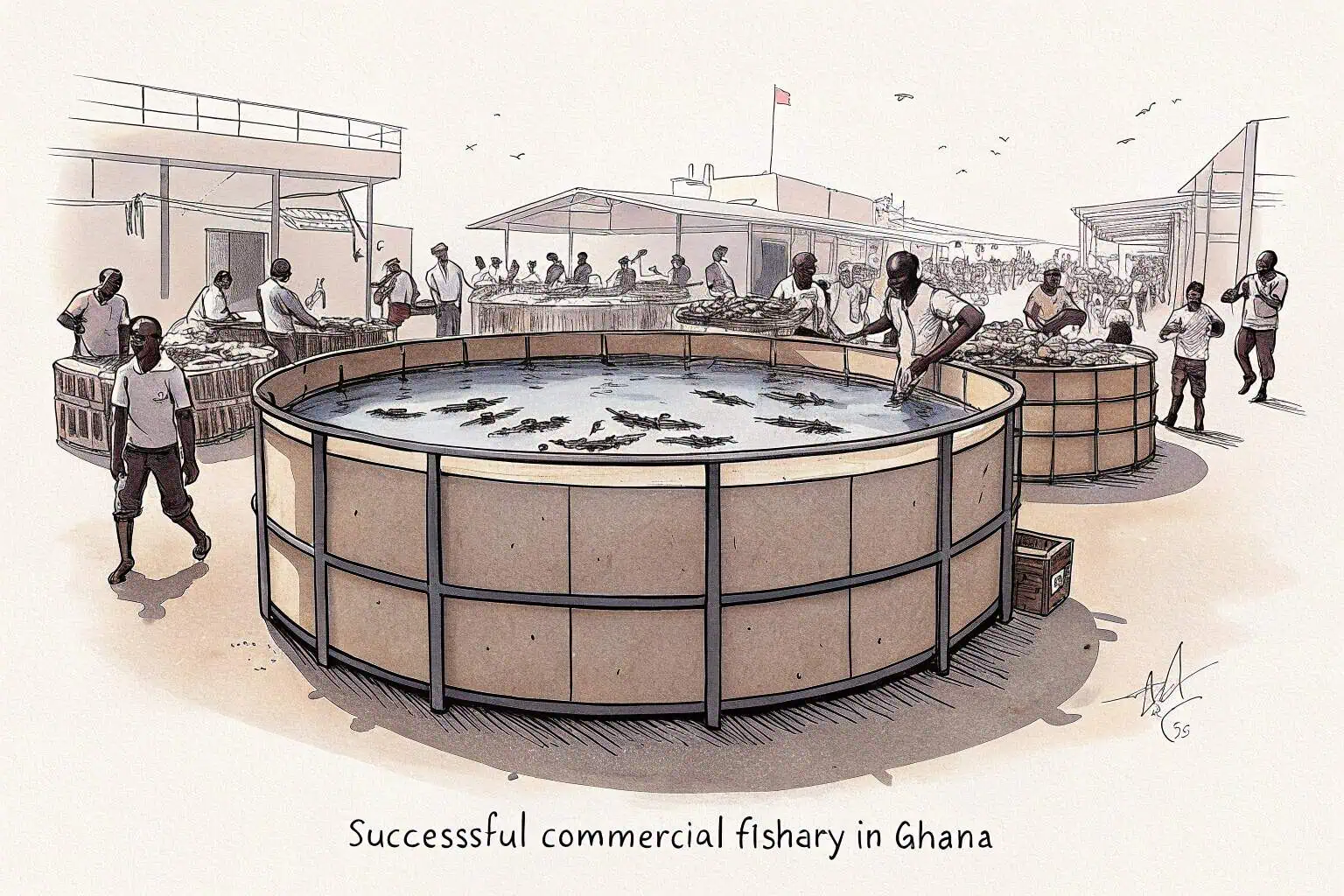What is good water quality for fish ponds in Ghana?
Struggling with unhealthy fish and low yields in your pond? Poor water quality is often the hidden cause. Knowing the ideal conditions is crucial for success.
Good water quality in Ghanaian fish ponds means clear, well-oxygenated water with balanced pH and low levels of harmful substances like ammonia and nitrites, ensuring fish thrive.

Maintaining optimal water quality is a continuous effort, but it's the cornerstone of successful aquaculture. It's not just about clear water; it's about creating a balanced ecosystem where your fish can flourish. As someone who has spent years in this field, I've learned that consistent monitoring and timely interventions make all the difference. Let's explore what this means for your fish ponds in Ghana.
What is the water quality in a fish pond?
Does your pond water genuinely support your fish? Numerous factors define water quality; ignoring them can lead to significant problems. It's far more than meets the eye.
Fish pond water quality refers to its physical, chemical, and biological characteristics, including temperature, clarity, dissolved oxygen, pH, and nutrient levels, all vital for aquatic life.

When I first started, I thought as long as the water looked clean, everything was fine. I quickly learned that invisible factors1 are often the most critical. For instance, a sudden drop in dissolved oxygen, which you can't see, can be fatal. Water quality isn't a static thing; it changes with weather, feeding practices, and even the number of fish. Understanding these dynamics is the first step. We need to look deeper into what makes water suitable for our fish.
Key Physical Parameters
Temperature and turbidity are two physical aspects I always monitor. Fish are cold-blooded, so water temperature directly affects their metabolism, growth, and even their immune system. In Ghana, with its tropical climate2, managing high temperatures can be a challenge. Turbidity, or how cloudy the water is, can also be an issue. High turbidity can reduce light penetration, affecting natural food production, and can also irritate fish gills.
| Parameter | Ideal Range (General) | Importance for Fish |
|---|---|---|
| Temperature3 | Varies by species | Affects metabolism, growth, oxygen levels, immunity |
| Turbidity4 | Low | Affects light penetration, gill health, feeding |
Essential Chemical Parameters
This is where things get a bit more technical, but it's crucial. Dissolved oxygen (DO)5 is perhaps the most important. Fish need it to breathe, just like we need air. Low DO is a common cause of fish kills. Then there's pH6, which measures how acidic or alkaline the water is. Most fish prefer a neutral pH, around 6.5 to 8.5. Ammonia, nitrite, and nitrate are nitrogen compounds. Ammonia and nitrite are highly toxic to fish, even at low concentrations. These come from fish waste and uneaten food. Proper management involves ensuring these are kept at minimal levels.
Biological Aspects
Beyond the chemicals, the biological components like algae and bacteria play a huge role. Some algae are good – they produce oxygen and serve as food. But an overgrowth, an algal bloom, can deplete oxygen at night and sometimes release toxins. Beneficial bacteria are essential for breaking down harmful ammonia into less harmful nitrate, a process called nitrification. Maintaining a healthy balance of these microorganisms is key to a stable pond environment. I've found that using products like our Bancy collapsible fish tanks7 can make managing these parameters easier due to their controlled environment and ease of cleaning.
What is the water quality index in Ghana?
Perhaps you're seeking a standard benchmark for water quality in Ghana. While a specific, universally adopted "fish pond water quality index" isn't formally set for private ponds, general guidelines do exist.
Ghana relies on general environmental water quality guidelines and standards set by bodies like the Environmental Protection Agency (EPA) Ghana, which can be adapted for aquaculture.

Navigating water quality standards can seem daunting, especially when you're trying to apply broad environmental rules to your specific fish pond. From my experience, the key is to understand the principles behind these guidelines and adapt them. The EPA Ghana8 provides benchmarks for various water bodies, and these are excellent starting points. For fish farming, we often need to be even more stringent because we're creating a concentrated, managed ecosystem. It's about taking those broader standards and refining them for the specific needs of the fish species you're raising. This proactive approach has helped me avoid many common pitfalls.
Understanding EPA Ghana Guidelines
The Environmental Protection Agency (EPA) of Ghana has established guidelines for ambient water quality. These are not always specific to aquaculture but provide a baseline for various parameters like pH, dissolved oxygen9, and levels of pollutants. For fish farmers, these guidelines are a reference point. For example, if the EPA sets a minimum dissolved oxygen level for rivers, you'd want your fish pond to be well above that, especially during warmer periods or when stocking densities are high. I always advise fellow farmers to consult the latest EPA publications or their local fisheries officers for the most relevant information.
Adapting Guidelines for Aquaculture
General water quality standards are a good start, but successful aquaculture often requires more specific targets. Different fish species have different tolerances. Tilapia, for instance, are quite hardy and can tolerate a wider range of conditions than, say, catfish or more sensitive ornamental species. My approach involves researching the optimal conditions for the specific fish I'm farming and then setting my own internal targets, which are often stricter than general environmental guidelines. This might mean aiming for higher dissolved oxygen levels or lower ammonia concentrations. Using reliable equipment, like our durable Bancy fish tanks10, helps in maintaining these specific conditions more consistently.
The Role of a Water Quality Index (WQI)
A Water Quality Index (WQI)11 is a tool that simplifies complex water quality data into a single number or rating (e.g., good, fair, poor). While Ghana may not have a specific WQI tailored only for fish ponds nationwide, the concept is useful. You can essentially create your own simplified index by regularly monitoring key parameters and scoring them. For example, you could assign points based on how close your pH, DO, and ammonia levels are to the ideal for your fish. This helps in quickly assessing the overall health of your pond and identifying trends over time. It's a practical way I track my ponds' performance.
What is the best water quality for a pond?
Many strive for the absolute peak conditions for their pond. The "best" water quality perfectly meets its inhabitants' needs and intended use, fostering a vibrant ecosystem.
The best water quality for a pond ensures high dissolved oxygen, stable pH, low toxins (ammonia, nitrite), appropriate temperature, and clarity, supporting healthy aquatic life and ecological balance.

Achieving the "best" water quality isn't a one-time fix; it's about creating and maintaining a dynamic equilibrium. I've learned that it's a combination of understanding the science and consistent, practical management. For me, the best water is water that not only keeps fish alive but allows them to grow vigorously, reproduce successfully, and exhibit natural behaviors. This often means going beyond minimum standards and striving for optimal conditions12. It’s about creating a little piece of aquatic paradise for your fish.
Core Components of Optimal Water Quality
To achieve the best, we need to focus on several core components. High dissolved oxygen (ideally above 5-6 mg/L for most warm-water fish) is non-negotiable. A stable pH13, typically between 6.5 and 8.5, prevents stress. Keeping ammonia and nitrite levels as close to zero as possible is crucial, as these are highly toxic. Water temperature should be within the preferred range for your chosen fish species. Good water clarity allows sunlight penetration for beneficial algae and makes it easier to observe your fish. These are the pillars I build my water management strategy on.
| Parameter | Optimal Level (General Warm-Water Fish) | Why It's Best |
|---|---|---|
| Dissolved Oxygen | > 5-6 mg/L | Essential for respiration, growth, stress reduction |
| pH | 6.5 - 8.5 | Prevents stress, supports biological processes |
| Ammonia (NH3/NH4+) | < 0.05 mg/L (un-ionized NH3) | Highly toxic, even at low levels |
| Nitrite (NO2-) | 30 cm | Indicates healthy plankton, allows observation |
Achieving and Maintaining the Best
Getting to this "best" state involves several practices. Proper aeration (using aerators or waterfalls) is key for oxygen. Regular water changes or a good biofiltration system14 help manage waste products like ammonia and nitrite. Careful feeding – not overfeeding – reduces waste. For temperature control, especially in a place like Ghana, providing shade or using deeper ponds can help. In my experience, using well-designed systems like Bancy's collapsible ponds15 can simplify some of these aspects, as they are easier to clean and manage than traditional earthen ponds, allowing for better control over the environment. Regular testing with reliable kits is also essential to know where you stand and make timely adjustments.
The Role of the Pond Ecosystem
It's also important to remember that a pond is an ecosystem. The "best" water quality also supports a healthy balance of beneficial bacteria, phytoplankton (microscopic algae), and zooplankton (microscopic animals). These organisms play vital roles in nutrient cycling16 and provide natural food for fish. So, managing for the best water quality isn't just about controlling negatives; it's also about fostering these positive biological processes. It’s a holistic approach that I’ve found yields the best results in the long run.
What is the best water quality for fisheries?
Is your primary goal to maximize your fishery's output? The ideal water quality for fisheries consistently promotes optimal fish health, rapid growth, and high survival rates, ensuring profitability.
For fisheries, the best water quality means consistently high dissolved oxygen, stable pH, minimal toxins, and suitable temperatures, tailored to the specific species being farmed for maximum productivity.

In commercial fisheries, water quality isn't just an environmental concern; it's a direct economic driver. Every parameter, from oxygen levels to ammonia, can impact your bottom line. I've seen firsthand how meticulous water quality management can transform a struggling fishery into a thriving one. It's about creating an environment where fish don't just survive, they prosper. This often means investing in good infrastructure, like our Bancy specialized aquaculture tanks, and robust monitoring systems17. The goal is to minimize stress and maximize growth potential.
Key Water Quality Targets for Productive Fisheries
For commercial success, certain water quality targets are paramount. Dissolved oxygen should ideally be maintained above 60-70% saturation, or >5 mg/L, especially during critical periods like early morning or after feeding. Un-ionized ammonia18 should be kept below 0.05 mg/L, and nitrite below 0.1 mg/L. pH stability within the 6.5-8.5 range is crucial. Temperature needs to be managed according to the species; for example, tilapia thrive in warmer waters (25-32°C), while trout need cooler temperatures. Consistent monitoring of these parameters allows for proactive management, preventing problems before they impact fish health and growth.
| Parameter | Target for High Productivity (e.g., Tilapia) | Impact on Fishery Success |
|---|---|---|
| Dissolved Oxygen | > 5 mg/L (ideally > 6 mg/L) | Supports high stocking density, fast growth, feed conversion |
| Un-ionized Ammonia | < 0.02 mg/L | Prevents gill damage, stress, disease susceptibility |
| Nitrite | < 0.1 mg/L | Prevents 'brown blood disease', ensures fish health |
| pH | Stable 7.0 - 8.0 | Optimizes physiological functions, reduces stress |
| Alkalinity | 50-150 mg/L as CaCO3 | Buffers pH changes, adds stability |
Management Practices for Superior Water Quality
Achieving these targets in a commercial setting requires diligent management. This includes appropriate stocking densities to avoid overcrowding, which strains water quality. Efficient aeration and water circulation systems are essential. A well-designed feeding strategy that minimizes waste is critical – uneaten food directly contributes to ammonia buildup. Regular partial water exchanges or advanced recirculation aquaculture systems (RAS)19 can help maintain pristine conditions. I've found that investing in quality infrastructure, such as Bancy's robust and easy-to-clean tanks, pays off in the long run by making these management practices more effective and less labor-intensive. Furthermore, having a solid bio-security plan helps prevent the introduction of diseases that can thrive in sub-optimal water conditions.
The Economic Imperative
Ultimately, for fisheries, the best water quality is an economic imperative. Healthy fish in good water convert feed more efficiently, grow faster, are more resistant to diseases, and have higher survival rates. This all translates to better yields and higher profits. It also means a better quality product for the consumer. In Ghana, where aquaculture is growing, focusing on these best practices for water quality will be key to building a sustainable and profitable industry20. It’s an investment that truly pays dividends, and it’s something I am passionate about helping others achieve.
Conclusion
In Ghana, maintaining good fish pond water quality by managing pH, oxygen, and toxins is vital for healthy fish and a successful, sustainable aquaculture industry for all stakeholders.
-
Invisible factors can significantly impact fish health. Discover more about these critical elements in water management. ↩
-
Learning about the challenges of fish farming in tropical climates can enhance your knowledge of sustainable aquaculture. ↩
-
Understanding the ideal temperature for fish species is crucial for their health and growth. Explore this link to learn more. ↩
-
Turbidity impacts light penetration and gill health in fish. Discover more about its effects on aquatic life. ↩
-
Understanding dissolved oxygen is vital for maintaining healthy aquatic life and preventing fish kills. Explore this link for in-depth insights. ↩
-
pH levels are crucial for fish survival. Learn how to manage pH for optimal fish health by exploring this resource. ↩
-
Discover how Bancy tanks can simplify fish care and enhance the health of your aquatic environment. ↩
-
Exploring the EPA Ghana's standards will provide you with essential benchmarks for maintaining optimal water quality in your fish pond. ↩
-
Dissolved oxygen levels are vital for fish health; exploring this topic can help farmers optimize their practices for better yields. ↩
-
Discovering the advantages of Bancy fish tanks can lead to better management of your aquaculture system, ensuring optimal conditions for your fish. ↩
-
Understanding WQI is crucial for assessing water quality effectively. Explore this link to learn more about its calculation and significance. ↩
-
This resource will provide you with valuable insights on how to create the best environment for your fish to thrive and exhibit natural behaviors. ↩
-
A stable pH is vital for fish health. Discover the effects of pH levels on aquatic life by checking this resource. ↩
-
Exploring biofiltration systems can provide insights into effective waste management, crucial for maintaining water quality. ↩
-
Discovering the benefits of Bancy's collapsible ponds can help you optimize your aquaculture setup for better efficiency and ease of maintenance. ↩
-
Discover the significance of nutrient cycling in maintaining a balanced ecosystem. This information is vital for pond management. ↩
-
Robust monitoring systems are crucial for maintaining optimal conditions in fisheries. Learn how they can boost your fishery's success. ↩
-
Exploring the effects of un-ionized ammonia can help prevent toxic conditions in fish farming, ensuring better yields. ↩
-
Discover the advantages of RAS, a key technology for sustainable aquaculture that enhances water quality and reduces waste. ↩
-
Exploring strategies for sustainability in aquaculture can lead to long-term success and environmental benefits. ↩